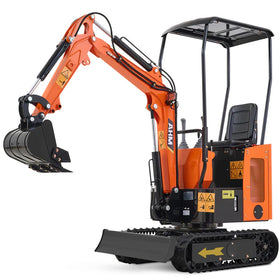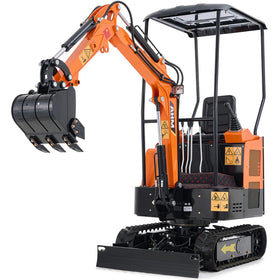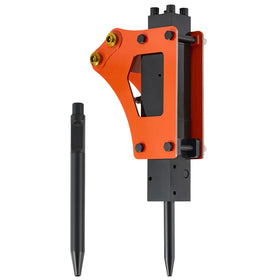Mini excavators are powerful and versatile machines, and their performance relies heavily on their final drive's hydraulic systems. These hydraulic systems are responsible for controlling the movement and torque delivered to the tracks. Hoses and pipelines are vital to delivering hydraulic oil to the final drives while minimizing the risk of hydraulic power loss. Conducting regular inspections of hoses and pipelines will likely prevent downtime, keep repair costs down, and extend the useful life of your mini excavator. This article will explore how to maintain hydraulic stability through hose and pipeline checks.
Why Hose and Pipeline Checks Matter
Final drives consist of hydraulic motors and gear systems that convert hydraulic energy into mechanical motion to drive the tracks of the mini excavator. The movement of hydraulic oil through a series of hoses and pipelines provides the required pressure and volume to the hydraulic motors.
A stable hydraulic system is vital for the full operation of the final drives. Any disruption—such as hose aging, cracks, leaks, or pipeline blockages—can result in reduced efficiency, uneven track movement, or even system failure. Further, if connections are loose or if the pipeline is damaged, it can not only create safety issues while operating but will also raises the maintenance cost of the mini excavator.
Regular inspection of hoses and pipelines helps detect potential issues early, ensuring both the safety of operators and the longevity of the equipment. By keeping these components in optimal condition, you maintain the smooth operation and reliability that mini excavators are known for.
How to Check Hoses and Pipelines for Mini Excavators
Before we begin the inspection steps, it’s important to note that the following procedure uses the AHM AX-12 13.5 HP mini excavator as an example. While your specific model may have slight variations, if there are significant differences, please refer to your own operator’s manual to ensure safety and accuracy.
NOTE 1: Any sprayed fluid can penetrate your skin, resulting in serious injury. Always use a paperboard to check for leakage. Furthermore, exercise extreme caution to keep your hands and body away from pressurized oil. In the event of an accident, seek immediate medical attention from a doctor experienced in treating trauma. Any fluid that penetrates the skin must be removed within a few hours to prevent complications like gangrene.
NOTE 2: Leaked hydraulic oil and lubricant may pose a fire hazard or cause personal injury.
STEP 1
Park the excavator on level ground. Lower the bucket to the ground. Set all control rods to neutral and shut off. Remove the ignition key.
STEP 2
Check the whole machine for any missing parts, loose pipe clamps, twisted hoses, pipelines, or hoses rubbing against each other. If any abnormalities are detected, refer to for replacement or tightening instructions.
STEP 3
Thoroughly tighten, repair, or replace any loose, damaged, or missing pipe clamps, hoses, pipes, oil coolers, and flange bolts. Do not bend or subject any pressure pipelines to impacts. Never install bent or damaged hoses or pipelines.
STEP 4
Securely attach the oil-pickup filter element cap, ensuring the filter and levers are correctly positioned, then tighten the bolts to 49 Nm.
Important: Starting the engine without hydraulic oil may damage the hydraulic pump.
STEP 5
Tighten the oil tank cap.
STEP 6
With the engine idling at low speed, gradually operate the lever for 15 minutes to purge air from the hydraulic system.
STEP 7
Fully retract the arm cylinder and extend the bucket cylinder to position the machine. Lower the bucket to the ground. Turn off the engine. Remove the ignition key. Check the hydraulic oil level in the tank and add more if necessary.
Common Issues During Inspection and Recommended Solutions
During routine inspections of the hydraulic hoses and pipelines associated with the final drives, operators commonly face several recurring issues:
Hose Wear and Damage: Cracks, bulges, or worn surfaces signal that a hose needs replacement. Always follow manufacturer guidelines for replacement intervals.
Loose Fittings: If the operators need to tighten any fittings, make sure it is done properly, without overtightening and damaging the threads or seals.
Oil Leaks: Make sure that all leaks are tracked down and repaired in a timely manner. If a leak in the system is ignored, the hydraulic system will lose efficiency and risk system failure.
Blockages and Contamination: Clean pipelines and use preventive maintenance to minimize clogging, which can restrict oil flow and reduce performance.
Conclusion
Hose and pipeline inspections are not optional—they are essential for maintaining the stability and efficiency of mini excavator final drives. By performing regular checks and adhering to a preventive maintenance plan, operators can ensure safer operation, reduce costly downtime, and extend the lifespan of their equipment. Establishing a routine inspection habit may take some time initially, but it pays off with smoother performance, fewer emergencies, and greater confidence in your mini excavator’s reliability.







